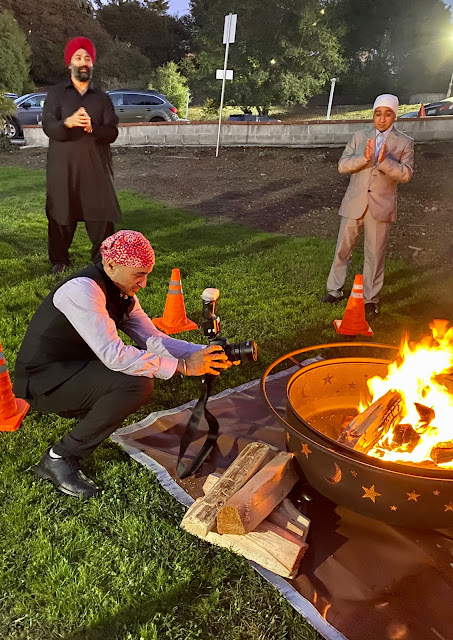After Baba ji ‘Matha teko’, Baba ji says, "I ‘ll be Ok all the day"
Tuesday, January 28, 2020
Monday, January 27, 2020
Making Of A CD Rom on Sri Guru Granth Sahib 1993-95
Wednesday, January 15, 2020
Tuesday, January 14, 2020
Sri Guru Granth Sahib Writers
a) Six Sikh Gurus, first Five (Guru Nanak dev ji, Guru angad dev ji, Guru Amar das ji, Guru Ram das ji, Guru Arjan dev ji) and ninth guru ji (Guru Teg bhadur ji).
b) 3 Sikhs (Bhai satta ji, Bhai Balwand ji and bhai Sundar ji).
c) 17 Bhatts :The Bhatts were a group of musicians who lived in the sixteenth century. All of them were scholars, poets and singers. (namely :Bhat Kal, Bhat Kalsehar, Bhat Tal, Bhat Jalup, Bhat Jal, Bhat Kirat, Bhat Sal, Bhat Bahil, Bhat Nal, Bhat Bhikha, Bhat Jalan, Bhat Kas, Bhat Gend, Bhat Sevak, Bhat Mathra, Bhat Bal and Bhat Harbans).
d)15 Bhagats (Kabir, Namdev,Ravidas,Sheikh Farid, Trilochan, Dhanna, Beni, Sheikh Bhikan, Jaidev,Surdas, Parmanand, Pipa, Ramanand, Sadhna, Sain).
Monday, January 13, 2020
Happy Lohri 2020
Dulla Bhatti And Lohri
Dulla Bhatti (popularly referred to as the "Son of Punjab" or "Robin Hood of Punjab", sometimes spelled Dulha Bhatti and also known as Abdullah Bhatti) (died 1599) came from the Punjab region of medieval India and led a revolt against Mughal rule during the reign of the emperor Akbar. Pindi Bhattian, Lahore Punjab, Mughal Empire.
Dulla was born to Ladhi four months after the death of his father. Coincidentally, Akbar’s son, Shaikhu (later known as Jahangir), was born on the same day. Advised by his courtiers that Shaikhu’s future bravery and success would be ensured if the child was fed by a Rajput woman, Akbar gave that responsibility to Ladhi despite her connection to a man who had rebelled against the Mughal throne. This decision appears to have its basis in realpolitik: Akbar perceived that Ladhi was resentful, that Bhatti might become the third generation of rebel and that royal favour might offset this part of the royal patronage was that Bhatti attended school. Although at that time unaware of the fate of his ancestors, he refused to accept the strictures that were intended to mould him into a good citizen and objected to being a part of an establishment that was designed to produce elites. He left to engage instead in childish mischief-making.A chance remark led to Ladhi having to explain the fate of Farid and Bijli to her son. Gaur says that this caused his general anti-authoritarian, rebellious nature to "crystallise" with the Akbar regime as its target, although not as a means of revenge specifically for the deaths of his relatives but in the wider sense of the sacrifices made by rural people generally. Bhatti saw this, says Gaur, as a "peasant class war".
Bhatti’s class war took the form of social banditry, taking from the rich and giving to the poor. Folklore gives him a legendary status for preventing girls from being abducted and sold as slaves; he arranged marriages for them and provided their dowries.
His efforts may have influenced Akbar’s decision to pacify Guru Arjan Dev Ji, and through Dev’s influence the people of Bari Doab, by exempting the area from the requirement to provide land revenues. The end for Bhatti came in 1599 when he was hanged in Lahore. Akbar had hoped to make an example of him at the public execution, expecting that he would quake with fear, but Bhatti was steadfast in his resistance to the end. Shah Hussain, a contemporary Sufi poet who wrote of him, recorded his last words as being "No honourable son of Punjab will ever sell the soil of Punjab". Only fragments of the vars (medieval poetry put to music) concerning Dulla Bhatti have survived to the present day and dhadi performances recounting his exploits have become less common. The memory of Bhatti as a saviour of Punjabi girls is recalled at the annual Lohri celebrations in the region to this day, although those celebrations also incorporate many other symbolic strands. The song "Sundri-Mundri" is sung during the celebrations and is a tribute to him.
In Punjabi folk tradition, Dulla Bhatti’s role in rescuing innocent girls from the clutches of lecherous men is enshrined in folk poetry that is sung during the winter festival of Lohri – which will be celebrated on Saturday. The chieftain is believed to have rescued two Brahmin girls, Sundri and Mundri, from Akbar, who wanted them in his harem. Dulla Bhatti became their godfather and is believed to have married them off on Lohri with much pomp and festivity, directly challenging the authority of the emperor. A popular song sung on Lohri goes:
"Sundri Mundriye hoe
Who will save you poor one
Dulla Bhatti is here for you
The Dulla married off his daughter."
In pre-Partition Punjab, Dulla Bhatti emerged as the ultimate symbol of the composite Punjabi culture – a Muslim landlord who fought for the honour of Brahmin girls, saving them from the Mughal emperor. Songs of his bravery were sung by Hindus, Sikhs and Muslims alike on Lohri, an indigenous festival that celebrates the end of the peak winter season. Much like other indigenous festivals of Punjab, Lohri slowly faded away from West Punjab. With the gradual death of the festival, the legend of Dulla Bhatti also faded away. Only occasionally are these stories and songs recalled by wayward travelers who happen to stumble upon his grave in the heart of Lahore, the glorious capital of the mighty Mughal Empire.
Haroon Khalid is the author of three books – Walking with Nanak, In Search of Shiva and A White Trail




























































